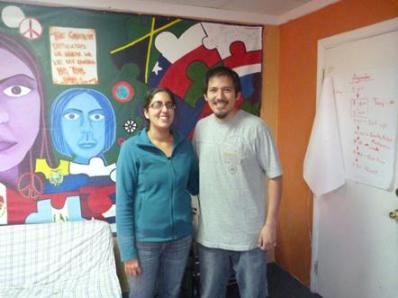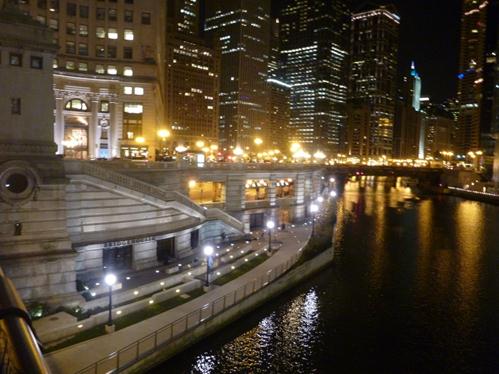 Friday 18th November 2011
Friday 18th November 2011
Jim Field (left), Director of Organizing at the Chicago Coalition for the Homeless, says he’s from the Alinsky generation and gives me a copy of the 1972 Playboy interview. He says lots of the first wave of organisers had taken vows of poverty and chastity which made the life easier. Jim was studying to be a Catholic priest but had been inspired by St Damian (who helped lepers) and took an internship at a school of nursing in 1968. That summer he dated an African American woman and the couple were stunned by the hostility everywhere they went. Jim became active in the civil rights movement and realised that his relationship was still illegal in 11 southern states. Over that summer he moved from a focus on service to a drive to change the world. He got involved in student politics but quickly became frustrated with the idea you could make change through argument. He came to grad school in Chicago and was signed up for an internship at Yellowstone. Then a friend of his met Alinksy and was “shaken up like a snow-dome”. For the first 15 minutes Alinsky had completely ignored him and they only spoke for 45 minutes but he was still twitching three days later! So Jim went to see an Alinsky assistant who talked about “democracy and social justice as a vibrant, live thing in a way I’d never heard”. So he dumped Yellowstone and took an organizing internship in Cicero (Al Capone territory, a very conservative town and the place Martin Luther King said scared him more than anywhere). Jim took a group to the town hall about a highway issue and the leaders were treated very badly. These were people with ‘America – love it or leave it’ stickers on their fridges but they went through transformation after that experience. Jim says the big change always comes when people “get in the river”.
The Coalition is 30 years old and is the only non-profit in Chicago combining law, policy and organizing elements. They have worked on the Sweet Home Chicago campaign to achieve the first low income housing ordinance in 20 years. They have five organizers – three in shelters/SROs, one working with an ‘outside base’ (schools, churches, etc) and one working with a state-wide network. Jim has worked in lots of different areas and talks about always adjusting to the environment. He criticises the ‘rigidity’ of some schools of organizing which remind him of religious sects – “we have the one true ideal; everyone else is going to hell!” He emphasises celebrating the victories – it’s a long way from getting in the pool to winning a medal so you definitely need an ice-cream after the first width.
Then I met Ed Shurna (right), the Coalition’s Executive Director, who also has 44 years of organizing behind him. Both Jim and Ed gave me lots of good advice for the English CO programme including, controversially, to “focus on the really good ones, don’t feel you need to spread your attention ‘fairly’. Instead develop success models that the others can aspire to.”
 Back at the El, I took the brown line to Kimball to meet with Jenny Arwade, Director of Albany Park Neighbourhood Council, another inspiring on-the-ground hub of organizing. Formed in 2000, APNC is funded by the band of four (Woods Fund, Wieboldt Foundation, Needmor and CS Mott) as a multi-issue community-based organization focused on organizing and youth development to build power. “No matter what issue, if a community member can bring others and is committed to spend some time on it, we will work with them.” There were horror stories about emergency health care with the uninsured being either turned away or sued for charges. APNC developed demands from talking to community leaders about their direct experience and targeted the local hospital. They won policy reforms around translation, making sure people are aware of the charity care forms, the appeals process. They have also worked to highlight the impact of foreclosures on renters after one of their leaders got a 30-day notice and tenants were treated badly by banks and the sheriff. They won a moratorium and have now achieved policy that banks have to sign an affidavit that they have respected tenants’ rights.
Back at the El, I took the brown line to Kimball to meet with Jenny Arwade, Director of Albany Park Neighbourhood Council, another inspiring on-the-ground hub of organizing. Formed in 2000, APNC is funded by the band of four (Woods Fund, Wieboldt Foundation, Needmor and CS Mott) as a multi-issue community-based organization focused on organizing and youth development to build power. “No matter what issue, if a community member can bring others and is committed to spend some time on it, we will work with them.” There were horror stories about emergency health care with the uninsured being either turned away or sued for charges. APNC developed demands from talking to community leaders about their direct experience and targeted the local hospital. They won policy reforms around translation, making sure people are aware of the charity care forms, the appeals process. They have also worked to highlight the impact of foreclosures on renters after one of their leaders got a 30-day notice and tenants were treated badly by banks and the sheriff. They won a moratorium and have now achieved policy that banks have to sign an affidavit that they have respected tenants’ rights.
Albany Park is very diverse with a large undocumented population. APNC started with outreach through door-knocking but then became institution-based, bringing together churches, mosques, universities, to hold ‘community dialogues’. The Founding Convention involved 1,200 people, truly reflecting all the differences, agreeing priorities across the whole community and ready to hold politicians accountable on a deeper level. Trusting relationships between institutions at this scale can achieve major victories, especially if you “build deeply locally and then form coalitions across the city and the state”.
Jenny says they have now realised the limitations of institutional membership and are looking to build an individual base on top. Institutions move slowly and their comfort levels are more difficult to challenge because they’re thinking about all their relationships and reactions. While a school may be a member, the young people may be disengaged from school so individual membership can deepen the relationships. The same with churches. APNC now has 300 individual members. The young members worked hard to decide on the protocols, the dues and the expectations.
“The history of organizing is about choosing models, but we don’t.” Jenny describes how door-knocking starts the process, surfacing superficial neighbourhood issues but igniting the passion that will get people to a meeting. A follow-up 1on1 creates a more personal relationship, ask where they’re from, what’s their experience, learn about them to understand more deeply. Take care only to ask about issues they will know/understand. On some issues wait until there’s been more political education. For APNC personal stories lead to issues, strategies, policy ideas, and deep bonds between people. It’s all about the leadership capacity of everyday people to change power that impacts on their lives. Jenny is clear that leaders need to be bringing people in, helping newer leaders. “You’re not a leader if you just want to speak out, if you’re not willing to door-knock and help others build those skills.” Get over the ‘leader’ barrier – reflect on small victories, analyse the problem, reflect on where the power was, that you made a difference, that you brought people in. This in itself is leadership.
Then I had the privilege of meeting Juan Cruz (b 1988) who came to Chicago from Mexico City aged 11. Thoughtful and inspired by the Zapatistas in Chiapas, he had high expectations of school but was disappointed and began getting into trouble. He came across APNC in 2003 when friends were coming to do their community service learning (40 hours of community work mandatory in the Chicago Public School system). Juan came to a training at APNC and was excited to find a place to talk about power issues and root causes.
He started working on a campaign for after-school resources. The old police station was vacant and the group wanted to turn it into a ‘teen centre’. “But there was a lot of politics in between”. There was a lot of support, including from the police, but the aldermen had other plans for the available funds. Looking back, Juan says they went in under-informed, with a lack of expertise about buildings, and therefore vulnerable to flannelling and divide-and-conquer tactics [which made me think with a smile of how revolutionary our Asset Transfer Unit is in its own way]. They’ve been building alliances since then and are better able to stand firm [another way Locality supports members].
Juan became a part-time youth intern at APNC when he graduated high school and after graduating from college he became full-time staff. He had wanted to be a teacher but “now I’ve been in organizing it’s hard to think about leaving. It’s like the Matrix. You can’t go back to not recognising what’s happening.”
My last night in Chicago deserved a deep-dish pizza-pie so I headed to Pizzeria Uno for 1,920 delicious calories (you can look it up online!). Then I walked home to take the edge off my gluttony and experience the lovely Michigan bridge at night. I loved the Wrigley building – a marvellous slab of white grandeur for a chewing gum company – and the Chicago Tribune (the WGN stands for World’s Greatest Newspaper!).



Next post – my last day, including organizing training from SOUL, and some reflections since
